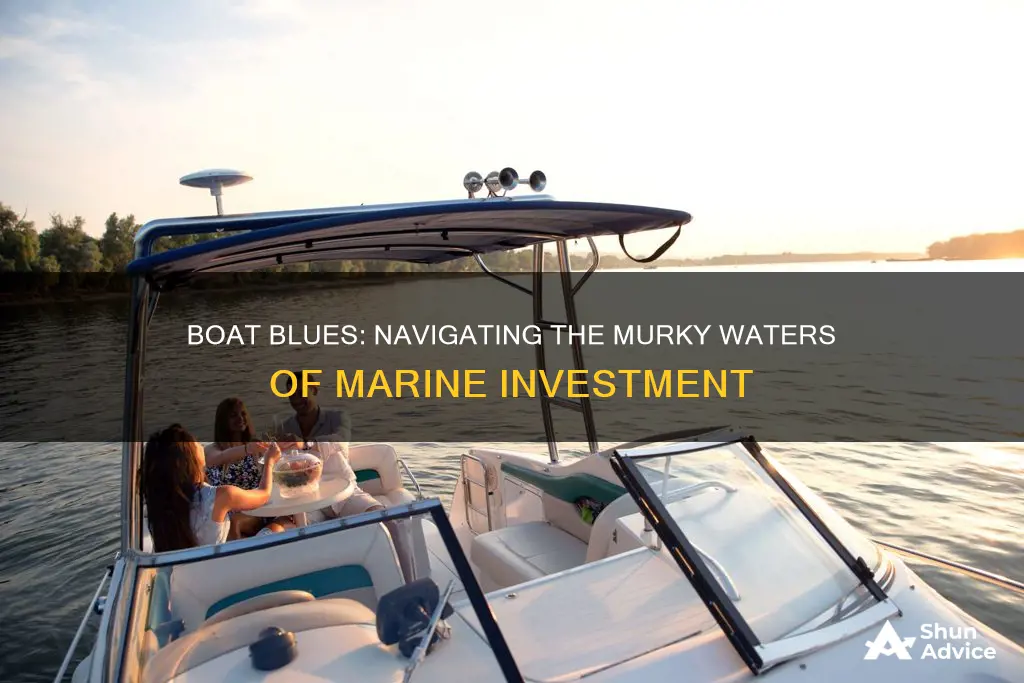
Owning a boat is often a romanticised concept, with many people dreaming of cocktails in the cockpit or landing monster fish with their friends. However, is buying a boat a good investment?
From a financial perspective, a boat is almost always a poor investment. Unlike other assets, boats rarely appreciate in value and are instead depreciating assets. The costs of ownership, including maintenance, storage, fuel and insurance, can be significant and are often underestimated by prospective buyers.
However, for those passionate about sailing and spending time on the water, the costs and hassles may be worth it. Additionally, there are ways to offset the costs of ownership, such as renting out the boat when it's not in use.
So, is buying a boat a bad investment? The answer depends on your priorities and how you plan to spend your recreational time and money.
| Characteristics | Values |
|---|---|
| Financial investment | Poor investment, unlikely to appreciate in value |
| Emotional investment | Can bring pleasure, adventure, freedom, and bonding with family and friends |
| Maintenance | Requires regular maintenance and repairs, especially if in saltwater |
| Storage | Requires storage, especially in colder climates |
| Fuel | Requires fuel |
| Insurance | Requires insurance |
| Registration | Requires registration |
| Accessories | Requires accessories |
| Training | Requires training to operate |
| Usage | May not be used enough to justify the cost |
What You'll Learn

Boats depreciate in value
Secondly, excessive usage can increase the natural wear and tear on a boat, leading to depreciation. However, regular maintenance can mitigate this effect, and a well-maintained boat with high usage can still retain its value.
Thirdly, the demand and supply dynamics of the boat market impact depreciation. Boats with less demand and more supply will depreciate faster. Popular boat brands and models tend to depreciate slower, as there is a larger market for them. Additionally, selling a boat during the peak season when demand is higher can help slow down depreciation.
Lastly, depreciation is also influenced by the location where the boat is sold. Areas with higher demand and lower supply, such as California or New York, may result in higher resale values compared to regions with steady demand throughout the year, like Florida.
While depreciation is a natural occurrence, there are ways to slow it down. Proper maintenance, buying a popular or limited-edition model, and selling at the right time can help retain the boat's value. However, it's important to note that boats are not typically considered an investment, as they are likely to depreciate over time and incur additional costs for maintenance, storage, insurance, and repairs.
Best ETFs to Invest in Now
You may want to see also

High maintenance costs
Owning a boat is often likened to throwing banknotes into a hole in the water. While this may be an exaggeration, the costs of owning a boat go beyond the purchase price. Maintenance is a significant expense, and it is important to be aware of the financial burden before buying a boat.
Annual maintenance for a boat is estimated to be around 10% of the boat's cost. This includes fixed costs such as registration and navigation fees, as well as variable costs like fuel and berthing fees. For a new boat, this can amount to thousands of dollars per year. For example, the average ownership cost of a new boat is $5,000-$8,000 annually. This figure varies depending on the size and type of boat, with small boats costing around $2,000 per year, while larger recreational boats can cost up to $8,000 per year.
Hiring professionals to maintain your boat can be costly, often 5-10 times more expensive than doing it yourself. For instance, the cost of winterizing a boat yourself is around $150, but hiring a professional can cost $300-$600 or more. Similarly, waxing a boat yourself might cost $150-$500, whereas hiring someone to do it could be $12-$25 per foot. Regular washing and cleaning can be done for $50-$300 per year if done by the owner, but hiring someone else to do it could cost $3-$5 per foot.
Boat maintenance is not just about keeping the boat looking good; it's also about ensuring its safety and functionality. Some tasks, such as servicing life rafts, inflatable vest cylinders, and fire extinguishers, require qualified professionals. Additionally, boats with engines need regular oil changes, which can cost $160-$190 if done by a mechanic.
The cost of maintenance also depends on whether the boat is stored out of the water or kept in the water. Boats that remain in the water are more susceptible to barnacle growth, which can occur within three months if not properly maintained. This requires additional maintenance to remove or prevent.
In summary, the high maintenance costs of boats can be a significant financial burden for owners. While some costs can be reduced by opting for do-it-yourself maintenance, many tasks require professional services. It is important for prospective boat owners to carefully consider the true cost of ownership, including maintenance, before making a purchase.
Investments: Paying with Potential
You may want to see also

Initial purchase price
The initial purchase price of a boat is one of the most significant barriers to entry for prospective boat buyers. The purchase price is often the smallest expense of owning a boat, with maintenance, repairs, storage, fuel, and insurance adding to the overall cost.
Boat owners should expect to pay about 10% of the purchase price annually in maintenance expenses, and more for older boats in the first year. Seasonal dockage or mooring fees are priced by the foot, so larger boats will be more expensive to dock. Fuel costs can also be significant, especially for powerboats or boats used frequently.
In addition to the ongoing costs, there are also one-off expenses to consider, such as winter storage and preparation for the boating season if you live in a colder climate. Repairs and maintenance, while sporadic, are also necessary. Boats need to be regularly cleaned, waxed, and polished, which takes time and money.
Insurance is another cost that cannot be avoided. It is mandatory if you have a boat loan or keep your boat in a marina, and it is recommended that you have a liability policy.
The purchase price of a boat is just the beginning, and potential buyers should carefully consider all the associated costs before making a decision. It is important to remember that the cost of owning a boat goes far beyond the initial purchase price and can quickly add up.
Bezos' Billion-Dollar Question: The Doge Dilemma
You may want to see also

Lack of training/confidence
Lack of training and confidence can be a significant barrier to enjoying boating as a hobby or investment. Many people struggle with self-doubt and anxiety, which can impact their ability to perform and enjoy new activities. This can be a vicious cycle, as not having confidence can lead to a reluctance to try new things and develop new skills, further reinforcing the lack of confidence.
When it comes to boating, a lack of confidence can be a safety issue. Boating requires a range of skills, from basic boat handling and navigation to more advanced skills like knot-tying and sailing. If you're not confident in your ability to handle a boat, it can be dangerous for both yourself and others.
So, how can you build confidence and improve your boating skills? One way is to invest in proper training and education. Taking a boating safety course or participating in on-water training can help you develop the skills and knowledge you need to feel confident on the water. These courses can cover a range of topics, from basic boat operation and safety to more advanced sailing and navigation techniques.
In addition to formal training, finding a mentor or experienced boater to learn from can be incredibly valuable. Having someone to guide and support you can help build your confidence and provide a sense of security as you learn. It's also important to get out on the water and practice. The more you familiarise yourself with your boat and the skills needed to operate it, the more confident you'll become.
It's also essential to be patient with yourself and remember that building confidence takes time. Everyone learns and progresses at their own pace, and it's normal to have setbacks or moments of self-doubt. The key is to keep trying, focus on your progress, and celebrate your successes.
Finally, it's worth considering the impact of your self-talk. Negative self-talk can undermine your confidence and performance. Instead, try to be mindful of your inner dialogue and practice positive self-talk. Remind yourself of your accomplishments and focus on the gains you've made, rather than your shortcomings.
By investing in training, seeking guidance, and practicing, you can overcome a lack of confidence and fully enjoy the boating experience. It may take time and effort, but building your confidence will ultimately enhance your enjoyment and help you make the most of your investment.
Investor Influx: Impacting Markets
You may want to see also

Storage expenses
There are three main options for boat storage: in-water storage, dry outdoor storage, and dry indoor storage. In-water storage is generally considered acceptable in areas with mild winters or if the boat is properly winterized with an agitator to prevent the water from freezing. Dry outdoor storage is a popular and relatively inexpensive option, often available at marinas, boatyards, and commercial storage facilities. Indoor storage, on the other hand, is more expensive but offers the most protection for the boat.
The exact cost of boat storage depends on factors such as location and boat size. Storage prices tend to reflect the local economy, with higher costs in areas with a high cost of living. The size of the boat also significantly impacts the storage costs, with larger boats requiring more space and resulting in higher fees.
Traditional indoor storage can range from $50 to $250 per month, while heated indoor storage, which provides protection from temperature fluctuations, can cost $250 to $500 per month. Open yard or outdoor storage is a more budget-friendly option, typically ranging from $45 to $90 per month. Dry stack storage, which offers easy access and better protection, can vary from $5 to $30 per foot per month. In-water storage or marina slip rental is another option, costing between $10 to $30 per foot per month.
Additionally, there are DIY storage options, such as storing the boat at home on a trailer, which can save on storage fees but may require additional investments in security and maintenance equipment. The cost of DIY storage depends on the available space and local regulations.
Overall, storage expenses can be a significant factor in the overall cost of boat ownership, and it is important for boat owners to consider their options and choose the most suitable and cost-effective solution.
Depression-Era Investments: Where Money Went
You may want to see also
Frequently asked questions
It depends on what you consider a good investment. Boats rarely increase in value and are associated with high maintenance costs, but they can bring pleasure and adventure.
Boats are almost always a poor financial investment. They depreciate quickly and are costly to maintain, with expenses such as fuel, maintenance, insurance, registration, and storage.
Yes, boat ownership can bring intangible benefits such as pleasure, adventure, and bonding with family and friends. It can also enable a range of activities, including fishing, tubing, cruising, and camping.
Consider buying a used boat, as it has already depreciated. You can also rent out your boat when you're not using it to offset the costs of ownership.
If you're looking for a more affordable way to enjoy boating, consider chartering or fractional ownership. Chartering allows you to rent a boat for your vacation, while fractional ownership involves sharing the costs and responsibilities of boat ownership with others.







